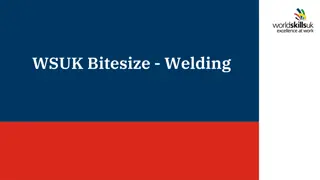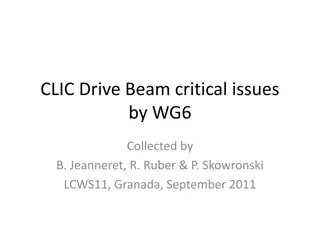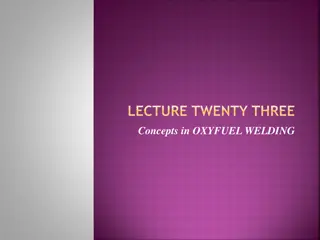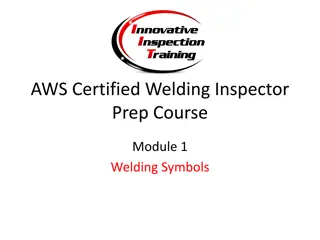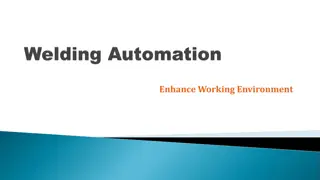Panel Project – Auto-Identifying Cobot Applications
Discover how collaborative welding robots, or welding cobots, are revolutionizing industrial welding applications. These cobots provide a smaller-defined work envelope, eliminating the need for traditional robot safety cages. Welder/operators can work and collaborate safely with the system, improvin
1 views • 21 slides
Welding business plan
The welding business plan is a strategic blueprint for a successful venture, including market analysis, financial projections, operational protocols, and marketing strategies. This comprehensive guide navigates the business through the competitive welding industry, fostering growth, efficiency, and
3 views • 49 slides
Understanding Electric Arc Welding and Its Processes in Metal Joining
Electric arc welding is a vital process for joining metal pieces through the application of heat or pressure. This technique involves the melting of parent metal, and electricity plays a crucial role in generating the required heat. Different welding processes, such as fusion welding and non-fusion
4 views • 21 slides
Advanced Microbunched Electron Cooling for EIC Design Overview
Microbunched electron cooling is a cutting-edge technique proposed for the Electron-Ion Collider (EIC) design, aimed at enhancing beam properties through coherent electron interactions. The concept utilizes Coherent Electron Cooling (CeC) and broad-band amplification in the form of Micro-bunched Ele
1 views • 16 slides
Welding Processes and Equipment Settings in Cast Iron Welding - EASA Electro-Mechanical Authority 2021 Conference
Explore the essential aspects of welding processes and equipment settings in cast iron welding discussed at the EASA Electro-Mechanical Authority 2021 Conference in Myrtle Beach, SC. Topics covered include SMAW, GTAW, GMAW, FCAW, safety reminders, proper machine settings, preheating, peening, and AW
2 views • 16 slides
Understanding Arc Forces in Welding: Gravity and Surface Tension Forces
Explore the significance of arc forces in welding, focusing on gravity and surface tension forces. Learn how these forces impact metal transfer, deposition efficiency, and welding quality. Discover the role of gravitational force in detachment and transfer of molten metal, and how surface tension fo
4 views • 25 slides
Exploring Welding as a Career Path
Discover the world of welding with insights on the role of a Welder, career progression, routes to become a welder, and required subjects for entering the sector. Learn about day-to-day responsibilities, potential earnings, and opportunities for growth within the welding industry.
0 views • 12 slides
Understanding Cathode Ray Tubes (CRT) in Oscilloscopes
Cathode Ray Tubes (CRTs) are key components in oscilloscopes, modulating and accelerating electron beams to create images of electrical waveforms, radar targets, and more. Unlike TVs, CRTs in oscilloscopes use electrostatic deflection for precise beam control. The electron gun assembly consists of a
0 views • 18 slides
Welding Materials Market worth $17
The report \"Welding Materials Market by Type (Electrodes & Filler Materials, Fluxes & Wires, Gases), Technology (Arc, Resistance, Oxy-Fuel Welding), End-use Industry (Transportation, Building & Construction, Heavy Industries), & Region - Global Fore
1 views • 3 slides
Understanding Heat Balance in Fusion Welding
In fusion welding, the heat balance is crucial for melting the metal efficiently. Factors like heat transfer, melting point, and energy conversion affect the amount of heat available for welding. The combination of heat transfer and melting factors reduces the net heat available for welding, impacti
0 views • 12 slides
Methods of Welding Arc Initiation and Maintenance
This lecture delves into the methods used to initiate and maintain the welding arc, including touch start and field start techniques. It explores the characteristics of the welding arc, temperature distribution, and factors influencing arc behavior. Touch start involves creating a small gap by bring
3 views • 16 slides
Welding Current Selection and Electrode Factors in Shielded Metal Arc Welding
When selecting the welding current for Shielded Metal Arc Welding (SMAW), considerations such as plate thickness, cable length, arc initiation ease, arc blow, and welding position play crucial roles. Direct Current (DC) is preferred for thin sheets and odd position welding, while Alternating Current
0 views • 10 slides
Hot Work Safety Training for Welding and Cutting Operations
Bureau of Workers Compensation in PA provides training on health and safety for welding, brazing, and cutting operations. The training covers general requirements for fire prevention and protection, working on floors with openings, fire watch requirements, and precautions before welding. It emphasiz
0 views • 34 slides
Understanding Fusion Welding Processes
Fusion welding processes such as Plasma Arc Welding (PAW) and Electron-Beam Welding (EBW) utilize high temperatures and focused energy sources to create strong bonds between metals. PAW achieves extreme temperatures of 17,000°C, enabling it to weld almost any metal with advantages like good arc sta
0 views • 12 slides
Gas Metal Arc Welding (GMAW) Equipment and Functionality Overview
Gas Metal Arc Welding (GMAW) is a versatile welding process that utilizes a consumable electrode wire, electric arc, and shielding gas to join metallic materials efficiently. This method requires essential equipment like power source, consumable electrode wire, wire feeder, welding gun, shielding ga
0 views • 10 slides
Critical Issues in CLIC Drive Beam by Working Group 6 at LCWS11
Issues identified in the CLIC Drive Beam project include RF stability and reliability, beam current stability, RF deflectors in combiner rings, synchrotron radiation power, beam dynamics, operability concerns, machine protection, and beam synchronization challenges. Key areas requiring attention inc
0 views • 5 slides
Beam-beam Effects in Future Hadron Colliders Workshop
Explore the beam-beam effects in the SPPC and future hadron colliders, presented at the International Workshop on High Energy Circular Electron-Positron Colliders. The workshop covers weak-strong beam-beam simulations, collision models, and parameter values for the SPPC. Detailed discussions on the
0 views • 32 slides
Choosing Parameters for Electron-Beam Lithography with the Raith EBPG
In the process of electron-beam lithography with the Raith EBPG, selecting parameters such as resist type, resist thickness, spot size, dose range, resist sensitivity, and beam step size is crucial for achieving precise patterns. Factors like the substrate, developer, and pattern transfer technique
0 views • 9 slides
Advanced Beam Diagnostics and Control Systems in Beam Physics
Cutting-edge detector technologies like KAPTURE and KALYPSO are revolutionizing beam diagnostics with ultra-fast Terahertz detectors and advanced line-camera systems. The POF III and POF IV projects focus on extreme beam control and diagnostics, aiming to probe femto-scale dynamics of relativistic p
0 views • 8 slides
Overview of Electron/Positron Injector Linac Upgrades at KEK
The recent status of the Electron/Positron Injector Linac at KEK, presented by Kazuro Furukawa, highlights the mission to achieve 40 times higher luminosity in the SuperKEKB collider. The upgrades include low emittance, low energy spread injection beams with higher beam current, new high-current pho
0 views • 23 slides
Wet Welding with Patented Water Interactive Coated Sticks
Wet Welding with the patented water interactive coated sticks offers operability, depth, and quality to surface standards of steel. Techniques such as hot passing and in-and-out puddle welding have been developed for high-strength steel applications. The system has been used in various scenarios, fr
0 views • 27 slides
Overview of Alternative Gases and Pressure Gas Welding in Oxyfuel Welding
Alternative gases to acetylene in oxyfuel welding, such as MAPP, propane, and natural gas, offer different characteristics and applications. Pressure gas welding (PGW) is a fusion-welding process that uses oxyacetylene gas and pressure to join metal parts without filler metal. The advantages, limita
0 views • 8 slides
Friction Stir Welding of Aluminum Plate: COMSOL Simulation
Manufacturers use friction stir welding to join aluminum plates efficiently. This modern method generates frictional heat to soften the aluminum, allowing dissimilar materials to be welded together. The model in COMSOL considers heat transfer and boundary conditions to simulate the welding process,
0 views • 8 slides
Ion Beam Intensity Enhancement Through Electron Heating in Collider Experiments
The study discusses electron heating of ions in collider experiments at the Collider V. ParkhomchukBINP facility in Novosibirsk. It explores the effects of electron cooling on ion beams, ion beam oscillations, losses, and ion beam intensity enhancement. Various factors such as ion charge, classical
0 views • 9 slides
Highlights of the 65th ICFA Advanced Beam Dynamics Workshop
The 65th ICFA Advanced Beam Dynamics Workshop featured insightful presentations on high currents, luminosity, and beam behaviors. Topics included beam pipe scrubbing, non-gaussian beam tails, and detector backgrounds. Presenters discussed progress in FCCee design, focus magnets, and beampipe concept
0 views • 32 slides
Instabilities Simulation and Observation at KEKB Accelerator Review Committee
In the 21st KEKB Accelerator Review Committee, instabilities related to beam size blow-up, coupled bunch instability, and electron cloud effects were discussed based on simulations and observations. Various studies were presented, including threshold beam currents, electron density simulations, and
0 views • 28 slides
Achieving High Average Beam Polarization in Particle Colliders
Detailed discussion on achieving high average beam polarization in particle colliders like CEPC, focusing on longitudinal polarized colliding beams, beam polarization requirements, basic formulas, and strategies for maintaining beam polarization during physics runs. Emphasis on scenarios involving s
0 views • 16 slides
Electron Lenses in Particle Accelerators: Advancements and Applications
Explore the use of electron lenses in particle accelerators for space-charge compensation, Landau damping, halo collimation, and beam-beam compensation. Learn about their history, applications in Tevatron and RHIC colliders, and current research areas. Electron lenses have shown promise in enhancing
0 views • 44 slides
Update on UE Beam Assumption for RRM Test Cases in 3GPP Meetings
The latest developments in 3GPP meetings regarding UE beam assumption for RRM test cases are outlined. Discussions include the need for UE beam type assumptions, updates to test cases for FR2, and upcoming presentations focusing on specific test cases and beam assumptions per test group. Test purpos
0 views • 9 slides
Understanding Electron Configurations and the Periodic Table in Chemistry
Explore the world of electron configurations in atoms, subshells, and electron arrangement using the periodic table. Learn about the organization of electrons in subshells, different ways to represent electron arrangements, and how to determine electron configurations based on the periodic table. Di
0 views • 12 slides
Automotive Grade 12 Safety Guidelines for Welding and Joining Equipment
Learn important safety precautions for welding and joining equipment in automotive grade 12. Understand the risks associated with arc welding and gas welding equipment, and follow guidelines to ensure operator safety, proper equipment usage, and ventilation. Proper handling of equipment, protective
0 views • 19 slides
Overview of Mu2e Slow Extraction Workshop at Fermilab by Vladimir Nagaslaev
This content discusses the Mu2e project at Fermilab, focusing on slow extraction techniques for beam delivery. It covers beam facilities, characteristics of Muon Campus, design requirements, beam losses, new MARS simulations, and losses in the extraction beam line. Details include beam kinetics, spi
0 views • 17 slides
Understanding Welding Symbols for Inspectors
Welding symbols play a crucial role in conveying information about weld joints to welding personnel. This module covers the basics of welding symbols, including parts, interpretation, groove welds, fillet welds, plug, and slot welds. As an inspector, it is essential to understand welding symbols to
0 views • 64 slides
Electron Beam Analysis and Optimization for RF Linac in Inverse Compton Scattering
This research activity report discusses the analysis and optimization of a 6D phase space electron beam for RF Linac-based Inverse Compton Scattering radiation sources. It covers the SPARC_LAB Thomson Source and ELI-NP GBS, including experiments, simulations, and studies on beam parameters and struc
0 views • 26 slides
Understanding Scanning Electron Microscopes (SEM) and Electron Sources
Scanning Electron Microscopes (SEMs) utilize focused electron beams to produce high-resolution images by interacting with a sample's electrons. The electron source, such as the electron gun, plays a crucial role in forming fine electron beams for imaging purposes. Different types of electron sources
0 views • 12 slides
Design of a 10 MeV Beamline for E-beam Irradiation at UITF Wastewater Facility
This paper discusses the design of a 10 MeV beamline at the Upgraded Injector Test Facility for electron beam irradiation, focusing on wastewater treatment for environmental restoration. The use of electron beam irradiation is highlighted as an effective method to remove pollutants like 1,4 dioxane
0 views • 9 slides
Enhance Your Working Environment with Advanced Automation Systems
Our commitment is to provide reliable, cost-effective, and high-quality automation systems to enhance your working environment. We offer comprehensive welding engineering services with precision. Arcraft's automation equipment includes Welding Oscillator, Positioner, Cutting Gun, and more to help in
0 views • 14 slides
Welding Heat Flow and Cooling Rate Calculations
Understanding welding heat flow and cooling rate calculations is essential for determining the critical cooling rate in welding processes. Factors such as plate thickness, number of passes, and relative plate thickness play a crucial role in selecting the appropriate equations for calculating coolin
0 views • 10 slides
Fundamentals of Electron Beam Ion Sources for Ionization: A Comprehensive Overview
Delve into the intricacies of Electron Beam Ion Sources (EBIS) and Electron Beam Ion Traps (EBIT) with a focus on their historical development, key operating principles, and main concepts. Explore the production of high charge states for accelerator applications, electron beam confinement, ionizatio
0 views • 10 slides
Challenges and Design of High-Intensity Accumulator for Neutrino Experiments
The presentation discusses the challenges faced in designing an accumulator for high-intensity particle beams in neutrino experiments at ESS Lund, with a focus on beam loss management, injection efficiency, and intense beam physics issues. The design considerations include beam holding capacity, bea
0 views • 30 slides






